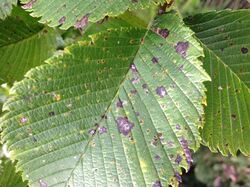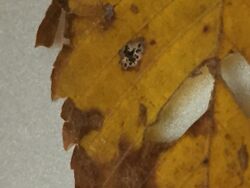Biology:Stegophora ulmea
| Stegophora ulmea | |
|---|---|

| |
| Symptoms of black spot on elm in the summer | |

| |
| Symptoms of black spot on an elm leaf in the fall | |
| Scientific classification | |
| Kingdom: | |
| Division: | |
| Class: | |
| Order: | |
| Family: | |
| Genus: | |
| Species: | S. ulmea
|
| Binomial name | |
| Stegophora ulmea (Fr.) Syd. & P. Syd., (1916)
| |
| Synonyms | |
|
Asteroma ulmeum (Miles) B. Sutton, (1980) | |
Stegophora ulmea is a foliar disease of elms commonly known as black spot of elm, twig blight, and elm leaf scab.[1] It is characterized by yellow spots that become black spots on the leaves. The pathogen is an ascomycete fungus native to North America. Stegophora ulmea is its teleomorph name.[2] It has two anamorph names, Gloeosporium ulmicolom referring to the macroconidia stage and Cylindrosporella ulmea referring to the microconidia stage.[1] This pathogen was formerly known as Gnomonia ulmea[3].
Hosts and symptoms
Stegophora ulmea infects all Ulmus species and Japanese zelkova.[2] It is most virulent on American white elm, Ulmus Americana[1]. Other elms it is known to infect include:[1]
- Ulmus alata (winged elm)
- Ulmus carpinifolia (European field elm)
- Ulmus crassifolia (cedar elm)
- Ulmus glabra (Wych elm)
- Ulmus hollandica (Dutch elm)
- Ulmus japonica (Japanese elm)
- Ulmus laciniata
- Ulmus laevis (European white elm)
- Ulmus parvifolia (Chinese elm)
- Ulmus procera (English elm)
- Ulmus pumila (Siberian elm)
- Ulmus serotina
- Ulmus thomasii (rock elm)
- Ulmus rubra (slippery elm)
- Zelkova serrata
Stegophora ulmea is characterized by chlorotic yellow spots 1 millimeter in diameter with a black center that develop early in the spring.[1][2][4] They darken and become raised. The black center can increase to occupy the entire chlorotic area.[4] The black spots can become about 5 millimeters in diameter.[1] As the season continues, the tissue around the original spot may become necrotic.[4] In severe cases of the disease there is premature shedding of leaves, blight of young leaves and shoots, and complete defoliation early in the fall.[1] Fruits that are infected become crumpled.[1] Infection of mature trees is rarely fatal.[1][2]
Disease cycle
In the spring, new leaves are infected with ascospores which develop from the survival structure, perithecia, found in leaf debris.[1] It is thought that inoculum from overwintered buds can also result in infection.[1][4] The perithecia are the structure in which S. ulmea survives the winter. Ascospore release is synchronized with the foliar development of the elms.[4] Ascospores commonly infect lower leaves and leaves near the bud.[1] A period of wetness and dryness with a temperature over 7 degrees Celsius is required before ascospores are released.[1] The ascospores disperse through the air and have the potential to travel over long distances.[1] Acervuli develop in the center of the lesions.[1] Acervuli can release macroconidia, which are white.[1] They mature 10–20 days after infection.[1] During spring and early summer, the macroconidia act as a secondary inoculum. This is the asexual part of S. ulmea’s life cycle.[1] Water is necessary for the dispersal of the macroconidia.[1] Microconidia are produced in the lesions during midsummer.[1] They act as spermatia in the sexual stage of the S. ulmea’s life cycle.[1] During late summer and fall perithecia, the sexual structure, begins to develop.[1]
Control
Sanitation, or removal all leaf debris seems to be the best method of control.[1] In commercial growing arenas, it is suggested that overhead watering should not be used, because it helps spread the pathogen.[1] Resistance greatly varies between species.[1] U. thomasfi seems to be the most resistant.[4] The majority of elms seem to be tolerant.[4] A dominant gene conferring resistance to U. parvifolia was discovered, though it did not provide absolute resistance.[5] There is currently no information about fungicides used to control this disease.[1] This disease is not typically fatal and is not actively addressed.[3] Aeration seems to moderately reduce growth and sporulation.[6] Cool temperatures and high humidity enhance the disease, so avoidance of these conditions will decrease the prevalence of disease.
References
- ↑ 1.00 1.01 1.02 1.03 1.04 1.05 1.06 1.07 1.08 1.09 1.10 1.11 1.12 1.13 1.14 1.15 1.16 1.17 1.18 1.19 1.20 1.21 1.22 1.23 1.24 1.25 "Stegophora ulmea". Blackwell Publishing. 2005. https://www.eppo.int/QUARANTINE/data_sheets/fungi/DS_Stegophora_ulmea.pdf.
- ↑ 2.0 2.1 2.2 2.3 Lane, Reed, Matthews-Berry (2013). "Rapid pest risk analysis for stegophora ulmea". https://secure.fera.defra.gov.uk/phiw/riskRegister/planthealth/documents/stegophoraUlmea.pdf.
- ↑ 3.0 3.1 "Elm diseases". Penn State Extension. 2016. http://extension.psu.edu/pests/plant-diseases/all-fact-sheets/elm-diseases.
- ↑ 4.0 4.1 4.2 4.3 4.4 4.5 4.6 McGranahan, G. H. (1982). Stegophora ulmea (Schwanniomyces: Fries) sydow & sydow: biology and host resistance (PhD thesis). The University of Wisconsin–Madison. ProQuest 8224058.
- ↑ Benet. H., guries R., Boury, S., Smalley E. (1995). "Identification of RAPD markers linked to a black leaf spot resistance in Chinese elm.". Theor Appl Genet 90 (7–8): 1068–1073. doi:10.1007/BF00222923. PMID 24173064.
- ↑ McGranahan G.H., Smalley E.B. (1984). "Conidial morphology, axenic growth and sporulation of stegophora ulmea". Phytopathology. https://www.cabdirect.org/cabdirect/abstract/19851304428.
External links
Wikidata ☰ Q7606707 entry
 |

